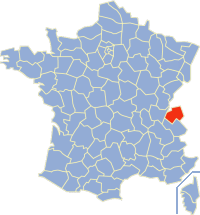
The following is a list of the 279 communes of the French department of Haute-Savoie.

Annecy is the prefecture and largest city of the Haute-Savoie department in the Auvergne-Rhône-Alpes region of Southeastern France. It lies on the northern tip of Lake Annecy, 35 kilometres (22 mi) south of Geneva, Switzerland.

The County of Geneva, largely corresponding to the later Genevois province, originated in the tenth century, in the Burgundian Kingdom of Arles (Arelat) which fell to the Holy Roman Empire in 1032.

Université Savoie Mont Blanc is a public university in the Haute-Savoie and Savoie departments of France, with one campus in Annecy, Haute-Savoie and two near Chambéry, Savoie.

Alfred-Henri-Marie Baudrillart, Orat. was a French prelate of the Catholic Church, who became a Cardinal in 1935. A historian and writer, he served as Rector of the Institut Catholique de Paris from 1907 until his death. He campaigned to rouse international support for France during the First World War, while in the Second World War he supported the Vichy regime and backed the Germans for leading the international struggle against Bolshevism.

The Diocese of Annecy is a Latin Church diocese of the Catholic Church in France, located 26 miles (42km) south of Geneva. Saint-Gingolph VS, a town in the Swiss canton of Valais, is also part of the diocese. Originally erected in 1822, after the Concordat as a suffragan of the archdiocese of Chambéry, the diocese of Annecy is composed of the entirety of the department of Haute-Savoie in the Region of Rhône-Alpes.

The Archdiocese of Chambéry, Saint-Jean-de-Maurienne, and Tarentaise is a Latin Church archdiocese of the Catholic Church in France and a suffragan of the Archdiocese of Lyon. The archepiscopal see is Chambéry Cathedral, located in the city of Chambéry. The archdiocese encompasses the department of Savoie, in the Region of Rhône-Alpes.

The French Roman Catholic diocese of Saint-Jean-de-Maurienne has since 1966 been effectively suppressed, formally united with the archdiocese of Chambéry. While it has not been suppressed, and is supposed to be on a par with Chambéry and the diocese of Tarentaise, it no longer has a separate bishop or existence.

Mouxy is a commune in the Savoie department in the Auvergne-Rhône-Alpes region in south-eastern France.

Quintal is a commune in the Haute-Savoie department in the Auvergne-Rhône-Alpes region in south-eastern France.

Gaspard Mermillod was a Swiss Cardinal of the Roman Catholic Church. Despite a lengthy investiture conflict with the Calvinist Canton of Geneva, he served as Bishop of Lausanne and Geneva from 1883 to 1891, having previously served as Titular Bishop of Hebron. He was made a cardinal in 1890.

Football Club d'Annecy is a French football club based in the town of Annecy, Haute-Savoie. The team plays its home matches at the Parc des Sports, where the club and its predecessor have been based since 1964. It currently competes in the Ligue 2.

The Diocese of Geneva was a Latin Church ecclesiastical jurisdiction or diocese in part of Switzerland and Savoy from 400 to 1801, when it merged with the Diocese of Chambéry. The merged diocese was later broken up, due to changes in national boundaries. The diocese of Chambéry lost Swiss territory to the Diocese of Lausanne, Geneva and Fribourg.

Charles Pierre Bertier was a French lawyer, magistrate, director of the Courrier des Alpes, Master of Requests to the Council of State and Governor of Martinique from 1867 to 1869. He is known for the role he played in defining the terms under which Savoy was annexed to France in 1860.
François-Marie Bigex was a prominent Savoyard churchman who was appointed Bishop of Pinerolo in 1817 and then, in 1824, Archbishop of Chambéry. His life and career were greatly affected by the French wars, which impacted Savoy directly between 1792 and 1815. He spent the most dangerous years of that period exiled in Lausanne, from where he was able to direct and undertake various missionary projects designed to combat the false doctrines that had arrived with the revolutionary armies from the west. His principal weapon in these endeavours was the pen.

Saint Clair of Dauphiné, also known as St. Clair of Vienne, was a Catholic abbot who "bequeathed to monasticism an example of religious excellence". He was born about 590 in Saint-Clair-du-Rhône and died in 660 in Vienne, France. His liturgical memorial is celebrated on January 1 in the Roman Martyrology.

The Bank of Savoy was a bank of issue of the Kingdom of Sardinia, established in 1851 and based in Annecy and Chambéry. As a consequence of France's annexation of the former Duchy of Savoy under the Treaty of Turin (1860), the Bank of Savoy ceded its money-issuance role to the Bank of France in 1865.

The term annexation of Savoy to France is used to describe the union of all of Savoy—including the future departments of Savoy and Haute-Savoie, which corresponded to the eponymous duchy—and the County of Nice, which was then an integral part of the Kingdom of Sardinia, with France in 1860. This union is expressed in the French version of the Treaty of Turin.

The Hôtel de Ville is a municipal building in Annecy, Haute-Savoie, southeastern France, standing on the Esplanade de l'Hôtel de Ville.

Charles-François Turinaz was a French Roman Catholic prelate who served as Bishop of Tarentaise (1873–1882) and later as Bishop of Nancy-Toul (1882–1918). A staunch defender of Catholic rights, he opposed secularist policies in France and played a significant role in promoting social Catholicism.



















